what causes cholera disease Cholera vibrio cholerae pediatrics histopathology mnemonics diarrhoea severe mumps
Cholera is an infectious disease caused by the bacterium Vibrio cholerae. It spreads primarily through contaminated water or food and is a major public health concern in areas with poor sanitation. The symptoms of cholera can be severe, including diarrhea, vomiting, and dehydration. In some cases, it can lead to death if left untreated. That’s why it’s important to understand the causes and symptoms of cholera and take steps to prevent its spread. One of the main causes of cholera is the consumption of contaminated water. This can happen when sewage mixes with drinking water sources, or when food is prepared with contaminated water. In areas with poor sanitation, it’s essential to boil water and avoid consuming raw fruits and vegetables that may have been washed with contaminated water. The bacterium that causes cholera, Vibrio cholerae, is also found in some types of seafood. Eating raw or undercooked seafood, such as oysters or shellfish, can increase the risk of infection. It’s important to cook these foods thoroughly before eating them. The symptoms of cholera usually appear within a few days of exposure to the bacteria. They can include severe diarrhea, vomiting, and abdominal cramps. Dehydration can also occur quickly, leading to symptoms such as dry mouth, sunken eyes, and rapid heartbeat. It’s important to seek medical attention immediately if you experience any of these symptoms, especially if they persist for more than a few days. Treatment for cholera typically involves rehydration and antibiotics. It’s important to replenish fluids and electrolytes lost through diarrhea and vomiting as quickly as possible. Oral rehydration solutions, which contain a balance of water, salts, and sugar, can usually provide sufficient rehydration. In severe cases, hospitalization may be necessary. Preventing the spread of cholera requires good hygiene practices and safe food and water sources. Washing hands regularly, cooking food thoroughly, and avoiding raw or undercooked seafood can help reduce the risk of infection. In areas with poor sanitation, it’s important to remain vigilant and take extra precautions to prevent the spread of the disease. Cholera is a serious public health concern, but with proper prevention and treatment, it can be managed effectively. By staying informed and taking steps to protect ourselves and our communities, we can help prevent the spread of this dangerous disease.
If you are searching about What Is Cholera? | GetDoc Says you’ve visit to the right place. We have 5 Pics about What Is Cholera? | GetDoc Says like Pathology of Cholera | Medical mnemonics, Medical knowledge, Emergency, Pathogen of the Month: Vibrio cholerae, the Causative Agent of Cholera and also What Is Cholera? | GetDoc Says. Here you go:
What Is Cholera? | GetDoc Says
 www.getdoc.comcholera cólera enfermedad contaminada causas contaminated spreads rtve getdoc pandemias diarrea timetoast cucarachas beber causa vaccine epidemias
www.getdoc.comcholera cólera enfermedad contaminada causas contaminated spreads rtve getdoc pandemias diarrea timetoast cucarachas beber causa vaccine epidemias
Pathogen Of The Month: Vibrio Cholerae, The Causative Agent Of Cholera
 www.gideononline.comcholera colera vibrio choléra cholerae infection identificati sintomo infezione pathogen causative symptôme globules leucocyte veine blancs niveau symptômes diseases diarrhea
www.gideononline.comcholera colera vibrio choléra cholerae infection identificati sintomo infezione pathogen causative symptôme globules leucocyte veine blancs niveau symptômes diseases diarrhea
Cholera: Overview And More
:max_bytes(150000):strip_icc()/cholera-overview-1958786_final-dd376d23599442c4b7ca41a219a8efe7.png) www.verywellhealth.comcholera treated prevent infection verywell verywellhealth
www.verywellhealth.comcholera treated prevent infection verywell verywellhealth
Cholera: Causes And Risk Factors
:max_bytes(150000):strip_icc()/cholera-causes1-5ad8b50743a1030037ac900f.png) www.verywellhealth.comcholera factors verywell verywellhealth
www.verywellhealth.comcholera factors verywell verywellhealth
Pathology Of Cholera | Medical Mnemonics, Medical Knowledge, Emergency
 www.pinterest.comcholera vibrio cholerae pediatrics histopathology mnemonics diarrhoea severe mumps
www.pinterest.comcholera vibrio cholerae pediatrics histopathology mnemonics diarrhoea severe mumps
Cholera: overview and more. Cholera colera vibrio choléra cholerae infection identificati sintomo infezione pathogen causative symptôme globules leucocyte veine blancs niveau symptômes diseases diarrhea. Pathology of cholera